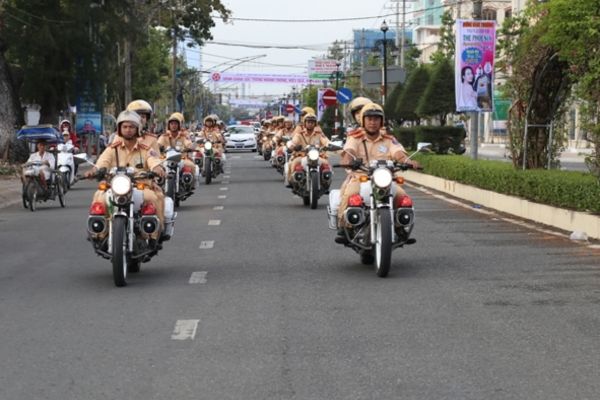Traffic Police Authorized to Stop Vehicles at Which Locations on Highways? Procedures for Traffic Police Control
Where Can Traffic Police Stop Vehicles on Expressways?
Based on the provisions in Clause 4, Article 16 of Circular 32/2023/TT-BCA as follows:
Stopping vehicles for inspection
....
4. When stopping and inspecting vehicles on expressways, the following requirements must be ensured in addition to the requirements stipulated in Clauses 2 and 3 of this Article:
a) Vehicle inspection at a single point is only allowed at the following locations: Toll stations, the beginning and end points of the expressway;
b) During mobile patrol and inspection, vehicles are only allowed to be stopped in the emergency stopping lane to inspect and handle violations in cases such as: Detecting serious violations of traffic order and safety that pose immediate risks; cooperating in fighting crime; natural disaster prevention, fire and explosion prevention; rescue operations; reports, denunciations, and reflections about violations of the law by vehicles and individuals traveling on the expressway; discovering vehicles stopping or parking improperly on the expressway. Upon resolving the matter, cones, barriers, and signs must be cleared immediately;
c) Place warning signs number 245a “Slow Down” or sign number 245b (for international routes) in front of the traffic police team in the direction of the vehicles to be inspected as per the road traffic signage laws.
Based on the above provisions, traffic police, when stopping and inspecting vehicles at a point on the expressway, are only allowed to stop vehicles at the following positions: toll stations, the beginning, and end points of the expressway.
Additionally, for mobile patrol and inspection on the expressway, traffic police are only allowed to stop vehicles in the emergency stopping lane to inspect and handle violations in the following cases:
- Detecting serious violations of traffic order and safety that pose immediate risks.- Cooperating in fighting crime; preventing natural disasters, fires and explosions; and conducting rescue operations.- Receiving reports, denunciations, or reflections about violations of the law by individuals and vehicles traveling on the expressway.- Discovering vehicles stopping or parking improperly on the expressway.
Upon resolving the matter, cones, barriers, and signs must be cleared immediately.
* Note: Traffic police stopping vehicles on the expressway must place warning sign number 245a “Slow Down” or sign number 245b (for international routes) in front of the traffic police team in the direction of the approaching vehicles.

Where Can Traffic Police Stop Vehicles on Expressways? What is the procedure for traffic police inspections? (Image from the Internet)
When Can Traffic Police Stop Vehicles for Inspection?
Based on the provisions in Clause 1, Article 16 of Circular 32/2023/TT-BCA, there are four cases in which traffic police officers on duty according to a plan are allowed to stop vehicles for inspection:
(1) Directly detecting or through technical and professional equipment collecting evidence of traffic law violations and other violations of the law;
(2) Executing orders and plans for traffic control to ensure road traffic safety and social order; patrol and inspection plans, handling violations according to specific plans to ensure road traffic safety and social order that have been issued by competent authorities;
(3) Receiving written requests from the head or deputy head of an investigative agency; requests from relevant functional agencies to stop vehicles for inspection to serve security and order assurances; crime prevention and combating; natural disaster prevention, fire and explosion prevention; disease prevention; rescue operations and handling other violations of the law. The written request must specify the time, route, vehicle to be stopped for inspection, handling, and coordinating forces;
(4) Receiving reports, reflections, petitions, or accusations from organizations or individuals about violations of the law by individuals and vehicles participating in road traffic.
What is the Procedure for Traffic Police Inspections?
Based on the provisions in Article 18 of Circular 32/2023/TT-BCA, the procedure for traffic police inspections is as follows:
Step 1: Request the vehicle operator to ensure safety measures and exit the vehicle.
Step 2: Salute according to the Public Security Forces protocol (except when it is known in advance that the person has committed a crime, is caught in the act, or is under a warrant). When interacting with individuals violating the law, traffic police officers must maintain proper posture, etiquette, demeanor, and conduct with appropriate behavior.
Step 3: Inform the vehicle operator and passengers of the reason for the inspection; request the vehicle operator to present relevant documents or provide information from related documents in the electronic identification account.
Step 4: Inspect the contents under Clause 2, Article 12 of Circular 32/2023/TT-BCA:
- Inspect the documents related to the vehicle and driver.- Inspect the conditions for vehicle participation in traffic.- Inspect compliance with road traffic safety regulations.- Inspect other relevant content as required by law.
For vehicles with more than 10 seats, or vehicles with dimensions equivalent to vehicles with more than 10 seats, inspection must be performed directly in the passenger cabin and results must be communicated.
Step 5: Conclude the inspection
Traffic police officers report the inspection results to the team leader, notify the vehicle operator and passengers of the inspection results, violations (if any), and the handling measures.
* Note:
- If there is a reason to believe that the participant in traffic, the vehicle, or the items hides contraband, equipment, documents used for violations, a search of the person, vehicle, or items may be conducted per administrative violation handling laws.- In case of discovering signs of crime, actions must be taken in accordance with criminal procedure laws.
LawNet